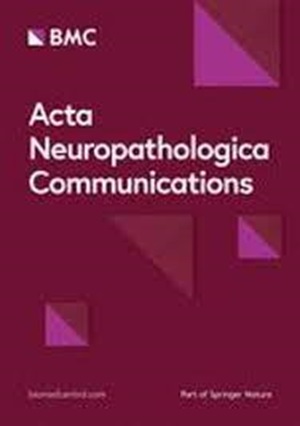Trem2-deficiency aggravates and accelerates age-related myelin degeneration
IF 6.2
2区 医学
Q1 NEUROSCIENCES
引用次数: 0
Abstract
Aging is the greatest known risk factor for most neurodegenerative diseases. Myelin degeneration is an early pathological indicator of these diseases and a normal part of aging; albeit, to a lesser extent. Despite this, little is known about the contribution of age-related myelin degeneration on neurodegenerative disease. Microglia participate in modulating white matter events from demyelination to remyelination, including regulation of (de)myelination by the microglial innate immune receptor triggering receptor expressed on myeloid cells 2 (TREM2). Here, we demonstrate Trem2-deficiency aggravates and accelerates age-related myelin degeneration in the striatum. We show TREM2 is necessary for remyelination by recruiting reparative glia and mediating signaling that promotes OPC differentiation/maturation. In response to demyelination, TREM2 is required for phagocytosis of large volumes of myelin debris. In addition to lysosomal regulation, we show TREM2 can modify the ER stress response, even prior to overt myelin debris, that prevents lipid accumulation and microglial dysfunction. These data support a role for Trem2-dependent interactions in age-related myelin degeneration and suggest a basis for how early dysfunctional microglia could contribute to disease pathology through insufficent repair, defective phagocytosis, and the ER stress response.Trem2缺失会加重和加速与年龄有关的髓鞘变性
衰老是大多数神经退行性疾病的最大已知风险因素。髓鞘变性是这些疾病的早期病理指标,也是衰老的正常现象;尽管程度较轻。尽管如此,人们对与年龄相关的髓鞘变性对神经退行性疾病的影响知之甚少。小胶质细胞参与调节从脱髓鞘到再髓鞘化的白质事件,包括通过小胶质细胞先天性免疫受体触发髓系细胞上表达的受体2(TREM2)调节(脱)髓鞘化。在这里,我们证明了Trem2缺失会加重和加速纹状体中与年龄相关的髓鞘变性。我们发现 TREM2 是再髓鞘化所必需的,它能招募修复性神经胶质细胞并介导促进 OPC 分化/成熟的信号。在脱髓鞘反应中,TREM2 是吞噬大量髓鞘碎片所必需的。除了溶酶体调节外,我们还发现 TREM2 还能改变 ER 应激反应,甚至在出现明显的髓鞘碎片之前就能防止脂质积累和小胶质细胞功能障碍。这些数据支持特雷姆2依赖性相互作用在与年龄相关的髓鞘变性中的作用,并为早期功能失调的小胶质细胞如何通过不充分的修复、缺陷吞噬和ER应激反应导致疾病病理提供了依据。
本文章由计算机程序翻译,如有差异,请以英文原文为准。
求助全文
约1分钟内获得全文
求助全文
来源期刊

Acta Neuropathologica Communications
Medicine-Pathology and Forensic Medicine
CiteScore
11.20
自引率
2.80%
发文量
162
审稿时长
8 weeks
期刊介绍:
"Acta Neuropathologica Communications (ANC)" is a peer-reviewed journal that specializes in the rapid publication of research articles focused on the mechanisms underlying neurological diseases. The journal emphasizes the use of molecular, cellular, and morphological techniques applied to experimental or human tissues to investigate the pathogenesis of neurological disorders.
ANC is committed to a fast-track publication process, aiming to publish accepted manuscripts within two months of submission. This expedited timeline is designed to ensure that the latest findings in neuroscience and pathology are disseminated quickly to the scientific community, fostering rapid advancements in the field of neurology and neuroscience. The journal's focus on cutting-edge research and its swift publication schedule make it a valuable resource for researchers, clinicians, and other professionals interested in the study and treatment of neurological conditions.
 求助内容:
求助内容: 应助结果提醒方式:
应助结果提醒方式:


